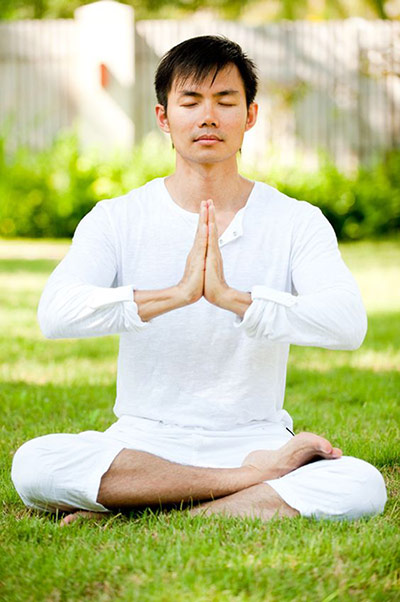How to Start a Yoga Practice
Here are 4 basic steps to starting a yoga practice.
1. Learn how to breathe
The most important thing to do in yoga is to breathe, especially when holding the postures. Learn Dirga and Ujjayi Pranayama to use during yoga. Most importantly, breathe through the nose into the belly. Read our Breathing in Asana article.

Breathing in Asana
Our natural tendency is to hold the breath or use stress induced breathing while holding a posture. This creates stress in the body. To create relaxation, breathe slowly and deeply in all of the asanas. There are several ways to breathe in asanas, and these will differ with teacher and tradition. I like to emphasize different breathing techniques or pranayamas while holding different postures.
Use Dirga pranayama in most postures. Focus on actively breathing into the chest in backbends and chest opening poses (pigeon, yoga mudra, warrior I, fish, bridge). For forward folding postures and belly down postures you can focus on just breathing into the belly (child, forward fold, cobra, boat)
Use Ujjiaj pranayama when holding strength building postures to increase endurance and focus (downward dog, standing squat, warrior III, warrior I, sun salutations).
Use Kapalabhati Pranayama when you want to intensify holding a pose and to strongly activate the prana in the body. Kapalabhati can also create a strong focus during an challenging pose to allow us to stay present with the posture.
2. Start and end with a brief Meditation
Start in easy pose or accomplished pose with a short meditation to center yourself and bring your focus inside.
Easy Pose Instructions
1. Come into a seated position with the buttocks on the floor, then cross the legs, placing the feet directly below the knees. Rest the hands on the knees or the lap with the palms facing up or down.
Optional: Use a hand mudra while seated in the posture.
2. Press the hip bones down into the floor and reach the crown of the head up to lengthen the spine. Drop the shoulders down and back, and press the chest towards the front of the room.
3. Relax the face, jaw, and belly. Let the tongue rest on the roof of the mouth, just behind the front teeth.
4. Breathe deeply through the nose down into the belly. Hold as long as comfortable.
Meditation
Meditation is a focusing of the mind on a single object, creating the cessation of all thought. As thoughts dissipate, the mind becomes quiet, and we are able to be fully in the present moment. The techniques of meditation are simple and easy to learn, but the ability to keep the mind focused takes time, patience and practice. The benefits of a regular meditation practice include reduction of stress, tension, anxiety and frustration, as well as improved memory, concentration, inner peace and whole body well-being.
3. Use Basic and Beginning Postures
Start with our basic yoga pose sequences and/or these simple postures:
seated twist, cat, dog, down dog, child, cobra, mountain, triangle, forward bend.

4. End with Shavasana (Relaxation Pose)
Always end your yoga practice with Shavasana, resting and consciously relaxing your body for 5-15 minutes.
Relaxation Pose Instructions
1. Lying on your back, let the arms and legs drop open, with the arms about 45 degrees from the side of your body. Make sure you are warm and comfortable, if you need to place blankets under or over your body.
2. Close the eyes, and take slow deep breaths through the nose. Allow your whole body to become soft and heavy, letting it relax into the floor. As the body relaxes, feel the whole body rising and falling with each breath.
3. Scan the body from the toes to the fingers to the crown of the head, looking for tension, tightness and contracted muscles. Consciously release and relax any areas that you find. If you need to, rock or wiggle part of your body from side to side to encourage further release.
4. Release all control of the breath, the mind, and the body. Let your body move deeper and deeper into a state of total relaxation.
5. Stay in Shavasana for 5 to 15 minutes.
6. To release: slowly deepen the breath, wiggle the fingers and toes, reach the arms over your head and stretch the whole body, exhale bend the knees into the chest and roll over to one side coming into a fetal position. When you are ready, slowly inhale up to a seated position.